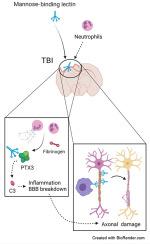Experimental Neurology ( IF 4.6 ) Pub Date : 2021-09-20 , DOI: 10.1016/j.expneurol.2021.113865 Jordi Pedragosa 1 , Domenico Mercurio 2 , Marco Oggioni 2 , Leonardo Marquez-Kisinousky 1 , Maria-Grazia de Simoni 2 , Anna M Planas 1

|
Leukocyte infiltration and blood-brain barrier breakdown contribute to secondary brain damage after traumatic brain injury (TBI). TBI induces neuroimmune responses triggering pathogenic complement activation through different pathways, including the lectin pathway. We investigated mechanisms underlying mannose-binding lectin (MBL)-mediated brain damage focusing on neutrophil infiltration and blood-brain barrier breakdown in a TBI mouse model. Wild type mice and MBL−/− null mice were subjected to controlled cortical impact. We studied neutrophil infiltration and regional localization by confocal microscopy 1, 4 and 15 days post-trauma, and investigated neutrophil extracellular trap (NET) formation. By immunofluorescence and/or Western blotting in various brain regions we studied the presence of fibrin(ogen), pentraxin-3, albumin and immunoglobulin G. Finally, we studied neurofilament proteins, synaptophysin, and αII-spectrin, and assessed white matter content in the injured tissue. TBI triggered an acute wave of neutrophil infiltration at day 1 followed by a more discrete persistence of neutrophils in the injured tissue at least until day 15. We detected the presence of NETs and pentraxin-3 in the injured tissue, as well as accumulation of fibrin(ogen), increased blood-brain barrier permeability, and neurofilament, synaptophysin and white matter loss, and calpain-mediated αII spectrin breakdown. MBL−/− mice showed reduced number of Ly6G+ neutrophils 4 days after TBI, lower accumulation of pentraxin-3 and fibrin(ogen) in the injured tissue, reduced global plasma protein extravasation, and better preservation of axonal and white matter integrity. These results show that MBL participates in secondary neutrophil accumulation and blood-brain barrier breakdown, and promotes axonal and white matter damage after TBI in mice.
中文翻译:

甘露糖结合凝集素促进小鼠脑外伤后血脑屏障破坏并加剧轴突损伤
白细胞浸润和血脑屏障破坏导致外伤性脑损伤 (TBI) 后继发性脑损伤。TBI 诱导神经免疫反应,通过不同途径(包括凝集素途径)触发致病性补体激活。我们研究了甘露糖结合凝集素 (MBL) 介导的脑损伤的潜在机制,重点是 TBI 小鼠模型中的中性粒细胞浸润和血脑屏障破坏。野生型小鼠和 MBL -/-空小鼠受到受控的皮质撞击。我们在创伤后 1、4 和 15 天通过共聚焦显微镜研究了中性粒细胞浸润和区域定位,并研究了中性粒细胞胞外陷阱 (NET) 的形成。通过免疫荧光和/或蛋白质印迹在不同大脑区域,我们研究了纤维蛋白(原)、pentraxin-3、白蛋白和免疫球蛋白 G 的存在。最后,我们研究了神经丝蛋白、突触素和 αII-血影蛋白,并评估了脑白质含量受伤的组织。TBI 在第 1 天触发了急性中性粒细胞浸润波,随后至少到第 15 天在损伤组织中中性粒细胞的持续存在更加离散。我们检测到损伤组织中存在 NETs 和 pentraxin-3,以及纤维蛋白的积累(ogen),增加血脑屏障通透性,和神经丝、突触素和白质损失,以及钙蛋白酶介导的 αII 血影蛋白分解。MBL-/-小鼠在 TBI 后 4 天表现出 Ly6G +中性粒细胞数量减少,受损组织中五聚体蛋白 3 和纤维蛋白(原)的积累减少,整体血浆蛋白外渗减少,以及更好地保持轴突和白质完整性。这些结果表明 MBL 参与继发性中性粒细胞积累和血脑屏障破坏,并促进小鼠 TBI 后的轴突和白质损伤。











































 京公网安备 11010802027423号
京公网安备 11010802027423号